The 10 Worst Foods To Eat for a Flat Belly
These foods may lead to bloading, gastrointestinal issues, or excess belly fat.
Your diet can impact how flat your stomach is in multiple ways. Whether it’s bloating, gastrointestinal issues, or excess fat around your belly, the flatness of your stomach is impacted greatly by the food and drinks you consume. Eating a balanced, nutrient-dense diet is key to a flat stomach, but knowing specific items that may affect this can help you feel more prepared in your goals.
The following list of “worst foods for a flat belly” consists of a variety of different types of foods, some of which we still highly recommend consuming on a regular basis. For instance, foods like cruciferous vegetables and legumes may cause bloating temporality, but they offer so many important health benefits that they still belong in your regular diet. On the other hand, some foods on this list are much better consumed in moderation because they may lead to excess belly fat and some health complications if eaten regularly, such as high-fat fast food and refined carbohydrates.
So while indulging in your favorite once-in-a-blue-moon foods can cause bloating in the short term and perhaps belly fat in the long term, many healthy foods can also cause your stomach to swell at times.
Below, dietitians explain which foods are some of the “worst” when it comes to belly flatness. Read on, then make sure to check out the 12 Best Foods for Defined Abs.
High-Fat Fast Food
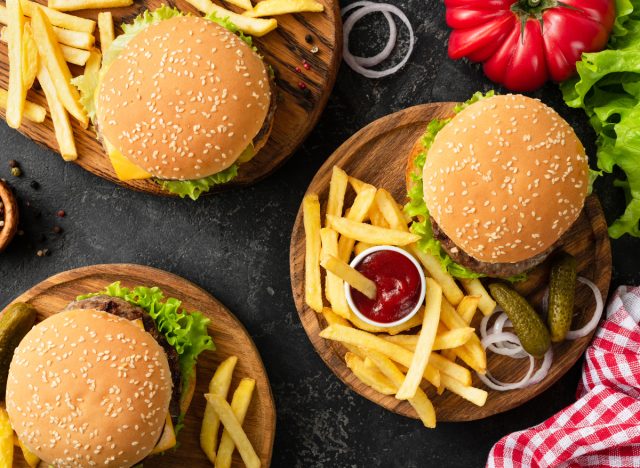
Some of our favorite fast food fare—think cheeseburgers and French fries—are sky high in calories, fats, and sodium, which is the perfect storm for a bloated belly. “Fast foods are very calorie-dense, meaning they provide a large number of calories in a relatively small amount of food. This can lead to consuming more calories than the body needs, particularly if they’re eaten frequently,” says Danielle Crumble Smith, RDN, LD.
The trans fats found in many fast foods are particularly concerning because they can increase the risk of abdominal obesity and related health problems, Smith says. “The high content of unhealthy fats can slow down the digestive process, leading to a feeling of fullness and bloating. Fats take longer to digest compared to carbohydrates and proteins, which can cause discomfort in the gastrointestinal tract,” Smith says.
And because fast foods are typically high in sodium, they can lead to water retention and a feeling of being swollen or bloated. “Sodium causes the body to retain water to maintain a balanced concentration of salts, which can result in temporary increases in weight and a bloated feeling,” Smith says.
Sugar Alcohols
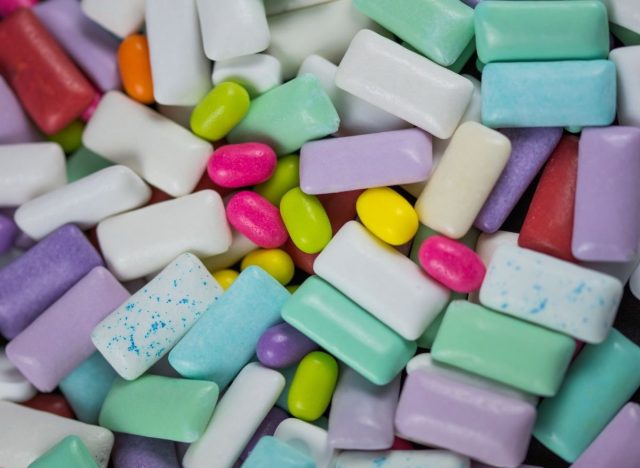
Foods sweetened with sugar alcohols or polyols are frequent culprits in gas production and bloating. “Sweeteners like mannitol and sorbitol are more difficult to digest—and when consumed, they travel through our digestive tract and promote gas production from the fermentation process in the large intestine,” says Annette Snyder, MS, RD, CSOWM, LD, a dietitian with Top Nutrition Coaching.
High-suspect foods include sugar-free mints or gum, hard candies, chocolates, and protein bars, but some natural foods can also contain polyols, such as dried plums, prune juice, pears, and pear juice, Snyder says.
To spot foods and drinks that may sneak in sugar alcohols, look under the “carbohydrates” section on a nutrition facts label, and added sugar alcohols should be listed under there. Snyder recommends looking for the ending “-ol” (as in sorbitol), or if not specifically named, check the ingredients list. Try to stick to items containing 5 grams or less of sugar alcohols—or aim to stay within 10 to 15 grams total per day to help avoid bloating.
Cruciferous Vegetables
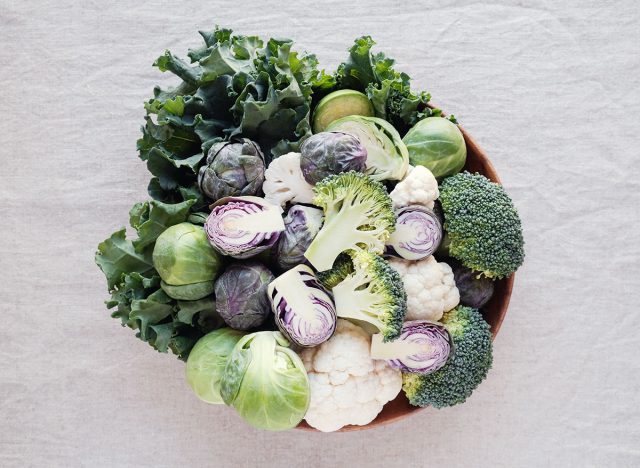
Cabbage, cauliflower, broccoli, and Brussels sprouts are all great nutrient-dense vegetables, but it’s their health-promoting properties that can cause bloating. “Cruciferous vegetables contain large amounts of sulfur compounds and complex carbohydrates like fiber,” says Snyder. “The sulfur compounds are called glucosinolates, and as they break down in the intestines, they form compounds like hydrogen sulfide, which is what can strongly impact the odor of gas.”
Even though they can cause bloating, these glucosinolates are also linked to protecting from serious diseases, including colorectal cancer, prostate cancer, breast cancer, and myocardial infarction, according to a 2021 report in The Development of Nutraceuticals and Traditional Medicine.
What’s more, cruciferous veggies have a type of complex carbohydrate called raffinose, and humans don’t have the enzyme to break it down. “When the undigested sugar hits the large intestine, the bacteria there start to ferment it and produce gas in the process,” Snyder says. The gas then can become trapped and cause bloating.
This shouldn’t deter you from diving into crucigerous vegetables. Instead of avoiding them, save the roasted broccoli side dish or the cauliflower pizza for a night in.
Potato Chips
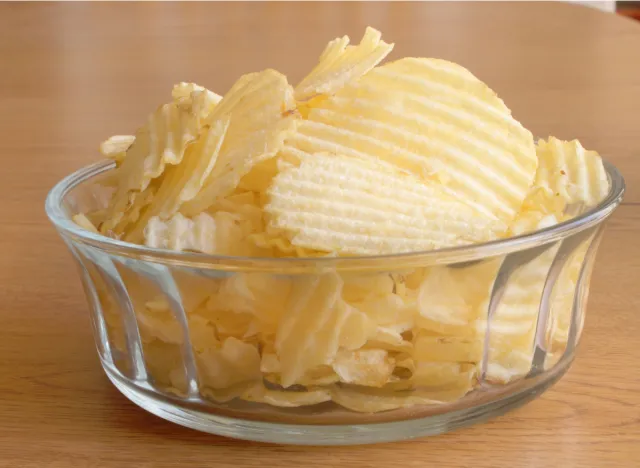
There’s a reason why health experts always recommend portioning out potato chips instead of eating them straight out of the bag: It’s almost too easy to consume a large amount in one sitting. Potato chips are usually high in both sodium and fat, which can contribute to bloating and weight gain.
“The fats used in potato chips are often saturated fats, which are more likely to be stored as body fat, particularly when consumed in excess,” Smith says. “They’re also high in simple carbohydrates, which are quickly broken down into glucose, leading to a spike in blood sugar levels followed by a rapid drop, which can increase hunger and lead to overeating.”
Plus, the high salt content in potato chips can cause water retention and bloating. All that said, it’s still okay to enjoy potato chips now and then—but be picky about the potato chips you choose. “Look for brands that have a very short ingredient list (less than five ingredients), and stick to the serving size on the nutrition label,” Smith recommends.
White Bread
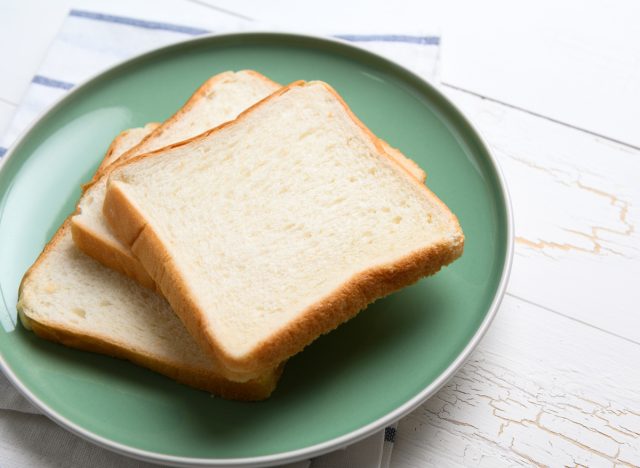
Fluffy white bread may be the reason you look forward to those lunchtime sandwiches, but it can contribute to bloating in the short term and potentially weight gain in the long term if it’s part of your regular diet.
“White bread has a high glycemic index, meaning it causes a rapid spike in blood sugar levels. This spike is followed by a quick drop that can cause hunger and stimulate a significant insulin response,” Smith says. Remember, insulin is a hormone that signals cells to store energy, primarily as fat—and over time, high insulin levels can lead to increased fat storage. “Foods with a high glycemic index can also cause the body to retain water, leading to a feeling of bloating and puffiness due to the body’s effort to balance blood sugar levels by pulling water into the bloodstream,” Smith says.
White bread is also very low in fiber, so it’s less filling than whole-grain toast. “This can lead to consuming more calories than needed, as it doesn’t provide the same level of satiety or fullness,” Smith says. Not getting enough fiber in your diet, which often is a product of choosing refined-grain products like white bread over whole-grain ones, can lead to constipation, which can also cause bloating.
“Additionally, in some individuals, refined carbohydrates like white bread can be rapidly fermented by gut bacteria, producing gas and causing bloating. This is especially true for people with sensitive digestive systems or conditions like IBS or SIBO (Small Intestine Bacterial Overgrowth),” Smith says.
White Pasta
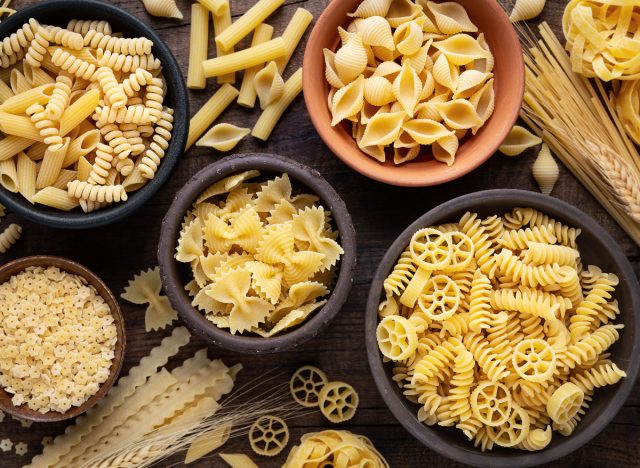
White pasta is a bloat and weight gain offender in the same way that white bread is. For starters, white pasta has a high glycemic index, so it can spike your blood sugar quickly, leading to carb cravings and an elevated insulin response, which can trigger fat storage over time.
What’s more, “regular consumption of refined carbohydrates can alter the balance of gut microbiota, potentially leading to dysbiosis, or an imbalance in gut bacteria that can cause bloating and other digestive issues,” Smith says.
And the toppings you pair your pasta with may also play a role in how puffy you feel. High-salt cheeses and meats can cause you to retain water, leading to bloat.
Legumes
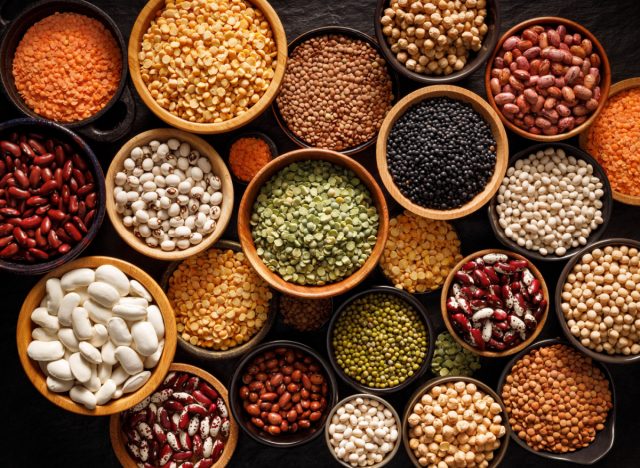
Legumes, which include foods such as kidney beans, black beans, chickpeas, and lentils, are rich in fiber. While fiber is a healthy nutrient that supports heart and gut health, consuming a large amount in one sitting — especially if your body isn’t used to a lot of fiber in your diet — can cause gas and bloating. And like cruciferous vegetables, legumes contain raffinose, a complex carb that humans cannot digest well, Snyder says. “When that compound reaches the large intestine, the bacteria there start to ferment it and produce gas.”
Still, legumes are an excellent source of fiber, plant protein, and other beneficial nutrients, so plan to incorporate them into your diet, just maybe not before an event or a night out.
You can find legumes canned, dried, in some gluten-free pastas or snack foods, or blended into meat-free alternatives — check the ingredients list if in doubt!
Dairy—if you’re lactose intolerant
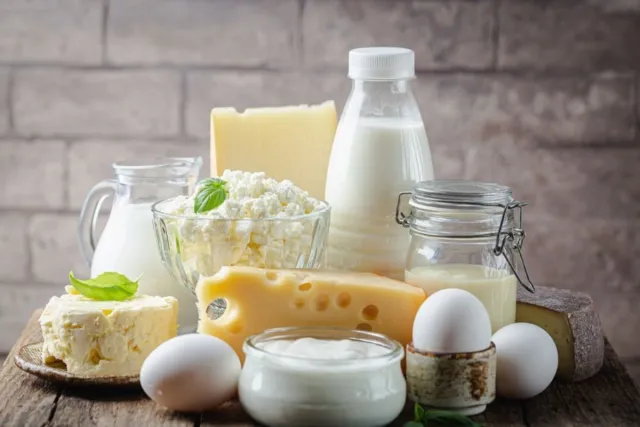
Cream cheese bagels and ice cream sundaes are common bloating culprits, but only in certain populations. People with lactose intolerance can’t digest lactose, a type of sugar found in dairy. When people with this common condition eat lactose-containing dairy, they’ll often experience bloating, gas, pain, and diarrhea. “Some people have lactose intolerance early on in life, while some develop an issue later. As we age, we make less of the enzyme (lactase) that breaks down lactose into simpler sugars that the body can handle,” Snyder says.
If you have lactose intolerance, foods like dairy milk and ice cream tend to be major culprits when it comes to bloating. “Foods with more of the lactose removed, such as hard cheeses, may be tolerated well. Yogurt may be tolerated in some [people], due to its active probiotic cultures,” Snyder says. Look for ingredients indicating a source of lactose (milk and milk powder), she suggests.
Alcohol
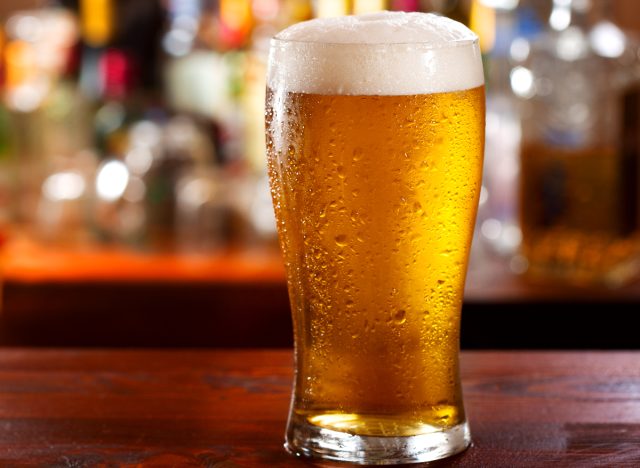
It’s called a beer belly for a reason. Beer is bloating in several ways: “First, it’s carbonated, so you swallow air as you drink, and that air can get trapped in the gut,” Snyder says. “Beer traditionally contains wheat and gluten, which can cause bloating, gas, pain, and/or diarrhea in someone intolerant to wheat or gluten,” Snyder adds.
But it’s not just beer that can lead to belly fat and bloating — it’s really any type of alcoholic beverage. “Alcohol itself interacts with our normal, healthy gut bacteria,” Snyder says. “When that balance of good bacteria changes, one may experience an increase in gas production and bloating.”
Drinking too much alcohol can cause belly fat not only because it’s high in calories, but also due to the way your body metabolizes it. “When you drink alcohol, your body prioritizes metabolizing the alcohol first. This process can slow down the burning of fats and other nutrients, leading to their storage in the body as fat,” Smith says. “Alcohol can also lower inhibitions, stimulate appetite and reduce self-control, which often leads to increased food intake, particularly of high-calorie, greasy, or sugary foods.”
But you may even notice the distending effects shortly after sipping a cocktail. “Alcohol can irritate the gastrointestinal lining, leading to inflammation and bloating,” Smith says.
Sugary Smoothies and Juices
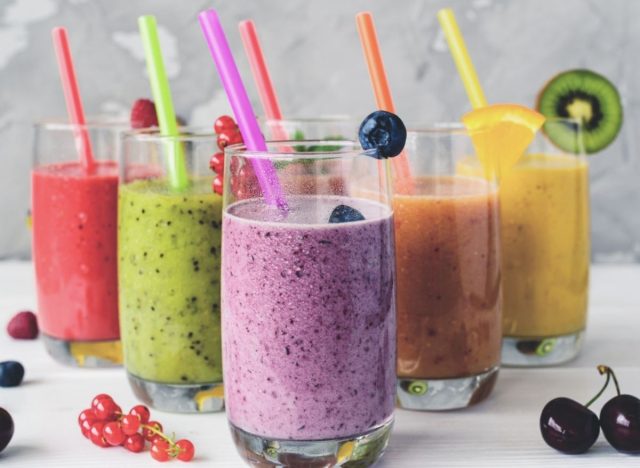
Juices and smoothies are often marketed as healthy drinks because they pack a few servings of fruit. But they’re often very high in calories and sugar, which can contribute to both weight gain and bloating.
“Liquid calories, especially those with minimal fiber and protein, are less satiating compared to solid foods, which means they can contribute to a higher overall caloric intake as they don’t make you feel as full,” Smith says. “And while fruits themselves are healthy, blending large quantities can lead to consuming more sugar and calories than you would typically eat if you were eating whole fruits.”
Not only that, but the high-sugar and low-fiber combination in these drinks can cause your blood sugar to spike, triggering the release of insulin, a hormone that regulates blood sugar levels by promoting the storage of glucose in tissues. “Frequent consumption of high-sugar smoothies can lead to consistently high insulin levels in the blood, encouraging the body to store more fat,” Smith says.
What’s more, certain sugars, such as fructose found in fruits, can be difficult for some people to digest fully. “This undigested sugar can be fermented by gut bacteria, producing gas and leading to bloating,” Smith says. And consuming too much sugar too often can disrupt the balance of gut microbiota, potentially leading to dysbiosis (or an imbalance in the gut bacteria), which can lead to digestive issues such as bloating.
It’s best to skip juices altogether since they’re usually completely devoid of fiber, but if you like drinking your fruits, make your own smoothies at home using a balanced recipe. Smith recommends including lower-sugar fruits (like berries), vegetables (like spinach or kale), sources of healthy fats (like avocado or nuts), and proteins (like Greek yogurt or protein powder) and keeping portion sizes reasonable.











